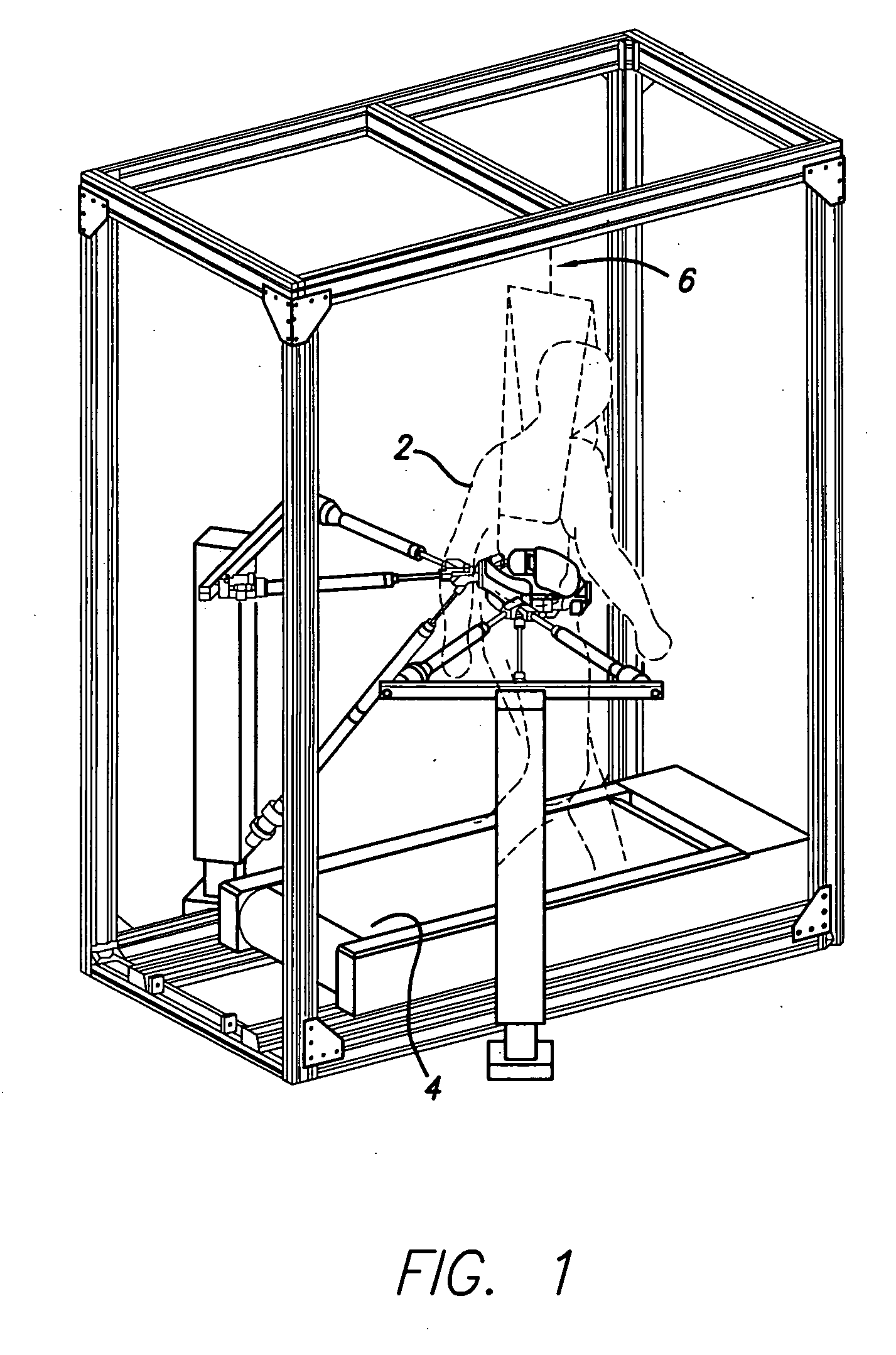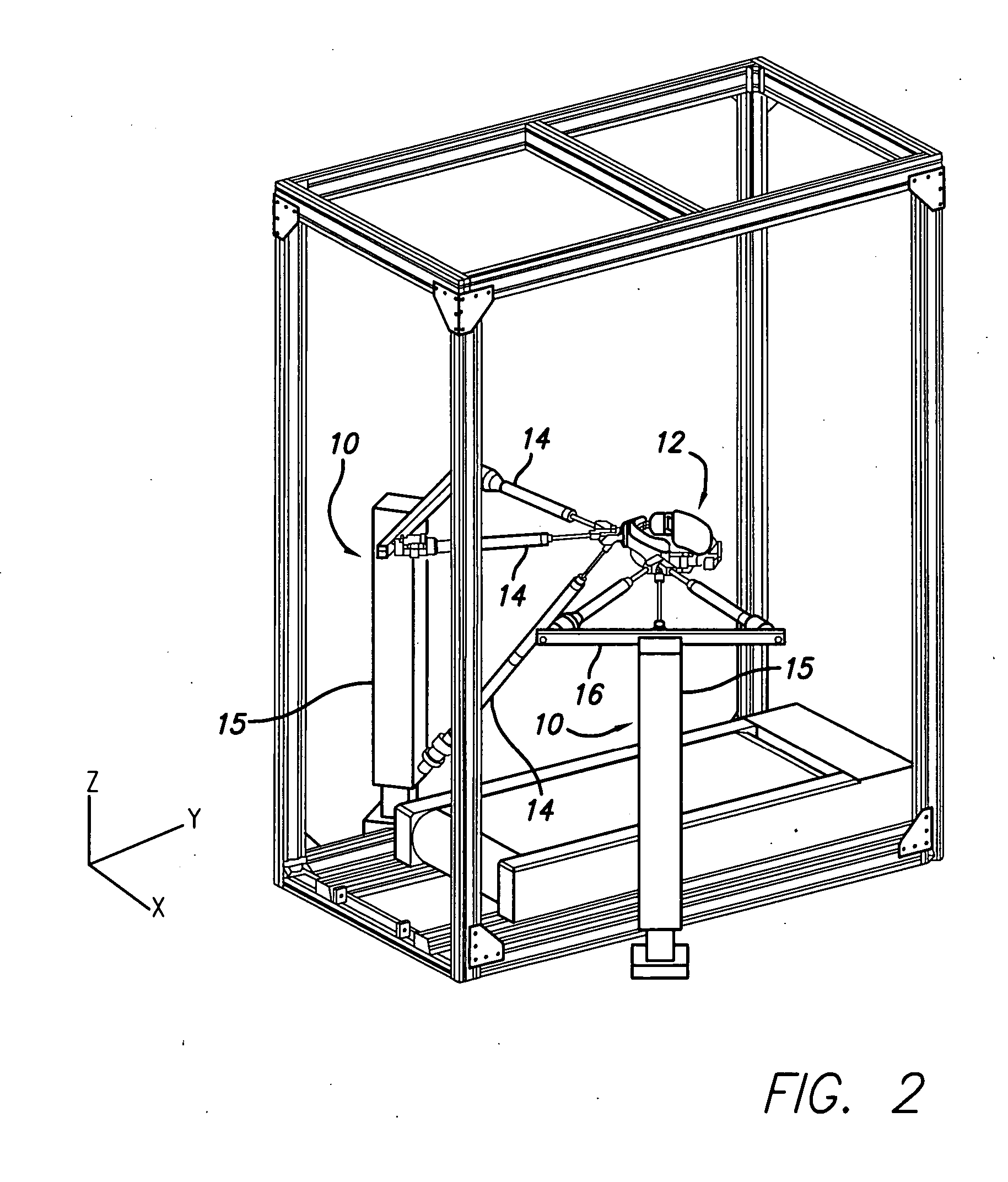Design of robotic gait rehabilitation by optimal motion of the hip
a robotic and hip technology, applied in the field of robotic gait rehabilitation, can solve the problems of limited clinical access to bws training, inability to optimally adjust the fixed trajectory of patients, and common impairment of walking ability after such neurologic injuries
- Summary
- Abstract
- Description
- Claims
- Application Information
AI Technical Summary
Benefits of technology
Problems solved by technology
Method used
Image
Examples
example 1
[0066] This example shows the robotic device in motion capture mode.
[0067] Each robot of the device uses three 1.5″ diameter pneumatic cylinders, each cylinder with a 12″ stroke. The device can generate about 350 lbs of force in the X-direction, 200 lbs of force in the Y-direction, and 140 lbs of force in the Z-direction, with reference to the X, Y and Z axes of FIG. 2, at a 100 PSI supply pressure. The positions of the cylinder rods are measured by an analog voltage signal from potentiometers that are integral within the cylinders. Pressures on each side of each cylinder are measured using low-cost pressure sensors. The system is controlled using Matlab xPC target.
[0068] The cylinder lengths can accommodate hip movement within an approximately 15-centimeter sphere. The resulting workspace allows for both normative and moderately exaggerated hip movements should they be necessary. FIG. 6A shows the workspace of the device in the horizontal (X-Y) plane, where the X, Y and Z axes ar...
example 2
[0072] This example shows the use of dynamic motion optimization applied to a fully actuated model. This model simulates normal human control of stepping.
[0073] Motion capture data was obtained from an unimpaired human subject with a height of 1.95 m and a weight of 75 kg. The sampling rate of motion capture was 60 Hz. The treadmill speed was selected to be 1.25 m / sec to approximate a speed commonly used in step training with BWS training. FIGS. 9A-C show one representative step with a duration of 0.5 sec that was chosen for comparison with the optimization results. The positions of the external markers were converted to link lengths and joint angles based on forward kinematics. The X, Y and Z axes are oriented as shown in FIG. 5. FIG. 9A shows the subject's gait along the X-Z plane. FIG. 9B shows a side view of the gait along the X-Y plane, where a solid line 90 represents the subject's swing leg during the step cycle and a dashed line 92 represents the configuration of the stance...
example 3
[0080] This example shows the use of dynamic motion optimization applied to an under-actuated model, which simulates a paralyzed subject.
[0081] For this analysis, the swing hip, knee and ankle joints were made passive. A total of 16 parameters (8 for each actuated joint) were used in the optimization. The optimization took approximately 3.5 hours to complete. The results are shown in FIGS. 13-15.
[0082] Referring to FIGS. 13A-C, FIG. 13A shows the gait in the X-Z plane, with a solid line 160 representing the optimized gait and a dashed line 162 representing the actual human data. FIG. 13B shows the gait in the Y-X plane, with a solid line 164 representing the optimized gait and a dashed line 166 representing the actual human data. FIG. 13C shows the gait in the Y-Z plane with the solid line 168 representing the optimized gait and the dashed line 170 representing the actual human data.
[0083] Referring to FIGS. 14A-G which show the joint angles in degrees during the step cycle, FIG....
PUM
 Login to View More
Login to View More Abstract
Description
Claims
Application Information
 Login to View More
Login to View More - R&D
- Intellectual Property
- Life Sciences
- Materials
- Tech Scout
- Unparalleled Data Quality
- Higher Quality Content
- 60% Fewer Hallucinations
Browse by: Latest US Patents, China's latest patents, Technical Efficacy Thesaurus, Application Domain, Technology Topic, Popular Technical Reports.
© 2025 PatSnap. All rights reserved.Legal|Privacy policy|Modern Slavery Act Transparency Statement|Sitemap|About US| Contact US: help@patsnap.com



